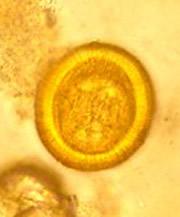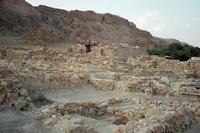 The ancient site was riddled with roundworm eggs - a sign that it was used as a toilet.J. Zias
The ancient site was riddled with roundworm eggs - a sign that it was used as a toilet.J. ZiasAn ancient Jewish sect showed such devotion to their definition of purity that they pursued bizarre toilet habits that left them riddled with parasites, say researchers who have discovered and dug up their toilet.
The discovery, made at Qumran, near Jerusalem, could provide more proof linking the Dead Sea Scrolls to the Essene people who lived in the area, the researchers claim.
The scrolls — the oldest biblical documents ever found — were thought to have been made by the Essenes around 100 years BC. Joe Zias, a palaeopathologist at the Hebrew University of Jerusalem dug around Qumran where he thought their toilet should be, and took soil samples to try and prove the connection once and for all.
“It shows what happens when people take biblical things too literally.”
Joe Zias, Hebrew University of Jerusalem
The scrolls describe strict rules for where the Essenes were allowed to defecate: far enough away from the camp not to be visible, sometimes as much as 3,000 cubits (1.4 kilometres) away in a northwesterly direction. They had to bury their faeces and perform a ritual all-over wash in the local waters afterwards.
At Qumran, following such instructions would take the Essene men to a nicely secluded spot behind a mound. And as Zias and his colleagues report in the current edition of Revue de Qumran1, the soil there bears the hallmarks of a latrine — and one not used by the healthiest of people.
Dirty bath water
Dead eggs from intestinal parasites, including roundworm (Ascaris), whipworm (Trichuris), tapeworm (Taenia) and pinworm (Enterobius vermicularis), were preserved in the soil. "If you look at a latrine from the past you will always find these parasites," comments Piers Mitchell, a medical practitioner and archaeologist at Imperial College London, UK.
It seems a pretty ordinary picture of ancient ill health, says Mike Turner, a parasitologist at the University of Glasgow, UK. He describes the pinworm rather aptly as "common as muck", adding that to use its presence to argue that the Essenes wrote the Dead Sea Scrolls is "an interesting bit of lateral thinking", he says.
 The Qumran site was home to the authors of the Dead Sea Scrolls, claim researchers.J. Zias
The Qumran site was home to the authors of the Dead Sea Scrolls, claim researchers.J. ZiasBut Zias is certain that the toilet was used by the scrolls' authors. He was already convinced that the Essenes lived at Qumran from previous studies of the local graveyard, which contains remains of almost exclusively men, which fits with the fact that the Essenes were a monastic sect.
What's more, the men buried there had an average age at death of 34, making them a sickly bunch. But it wasn't the toilet parasites that finished them off, Zias suggests, but their ritual of post-poo bathing in a stagnant pool.
ADVERTISEMENT
Geography worked against the Essenes because the pool in which they cleansed themselves was filled with run-off collected during the winter months. "Had they been living in Jericho 14 kilometres to the north, where one finds fresh spring water, or in other sites whereby one has an oasis, they would have lived quite well," Zias says.
The location of the latrine at Qumran conforms with the directions laid down in the Dead Sea Scrolls, proving that the Essene lived there, Zias claims. Sanitation around the time of the Essenes was good, and ordinary people were unlikely to go so far out of the city to defecate.
If his theory is correct, it might therefore carry a lesson about religious fundamentalism, Zias adds. "It shows what happens when people take biblical things too fundamentally or literally, as they do in many parts of the world, and what the ultimate consequences are."
Visit our ancientsects_extrem.html">newsblog to read and post comments about this story.
